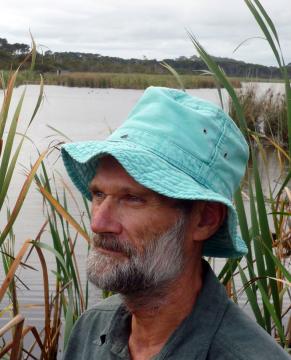Chapter 6: Water Balance Integration
Chloride is described as a conservative solute because its behaviour is simple and predictable and it does not fractionate during evaporation. Evaporating a closed body to half the original volume simply doubles the chloride content. Diluting the body with water of known chloride concentration permits the final concentration to be accurately predicted. Isotopes such as deuterium and oxygen 18 on the other hand are non conservative in that evaporation removes some of the isotope of interest. In a lake-aquifer system, isotope ratios are stable everywhere except at a lake surface where fractionation and enrichment occurs during evaporation. This behaviour or ‘isotope effect’ is governed by well defined rules which when applied allow these isotopes to be used in a similar fashion to conservative solutes. Knowing the isotopic ratio within the system components, mass balance equations can be solved to estimate the groundwater component in lake water balances.
For any given balance period (in this study every 4 days) the linear equations for the chloride and deuterium balance each define a family of chloride balance and deuterium balance solutions where for any mass of groundwater discharged into the lake, a corresponding mass of lake water recharged to the aquifer, can be defined. Final balance integration was done algebraically by solving for the intersection of the two linear equations. Discharge and recharge calculated using empirically and experimentally determined δE typically varied by less than 2%. In the diagrams typical graphical solutions are presented for East Lake in recharge, flow-through and transition between the two. Each diagram shows the data for two 4 day sub-balance periods. In the accompanying tables ‘Deuterium’ refers to solutions employing δE(lake) calculated from pan experiments at Perry Lakes. ‘Deuterium*’ refers to solutions employing Equation 23 of Craig & Gordon (1965). Only the solutions employing the locally derived pan experiment exchange parameters are plotted on the diagrams.
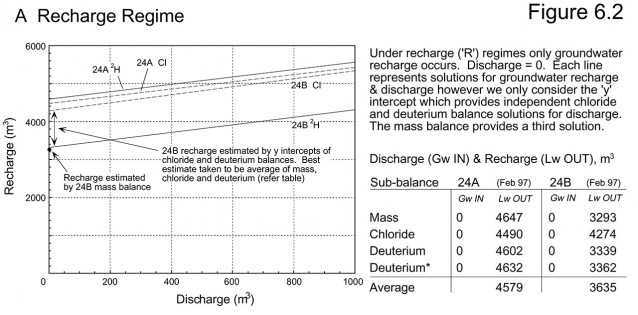
February 1997, East Lake is being artificially maintained and is mounded above the unconfined aquifer. Lake water is recharged to the aquifer. No groundwater is discharged into the lake. The mass balance therefore contains only one unknown (recharge) which is solved as the residual of the mass balance. Similarly chloride and deuterium are solved for zero discharge. The chloride and deuterium solutions plot as parallel (or near parallel) lines, their y intercepts being recharge. Here mass, solute and isotope balances provide three independent estimates of recharge, allowing an average 'best estimate'.
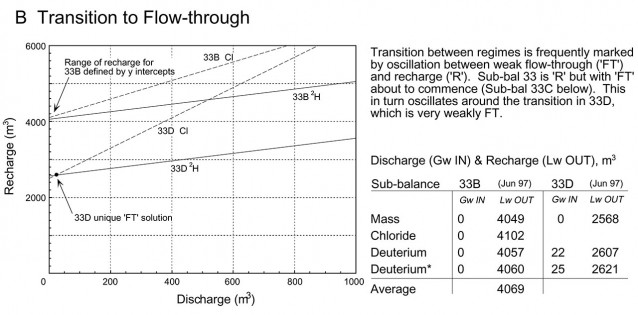
June 1997, winter rains have commenced. The transition between regimes is marked by oscillation between weak flow-through and recharge. These are common over winter when heavy rain and storm drain inputs push the lake into or close to recharge. The temporal resolution of our integrated balances was four days. At this scale it was not possible to resolve short term detail.
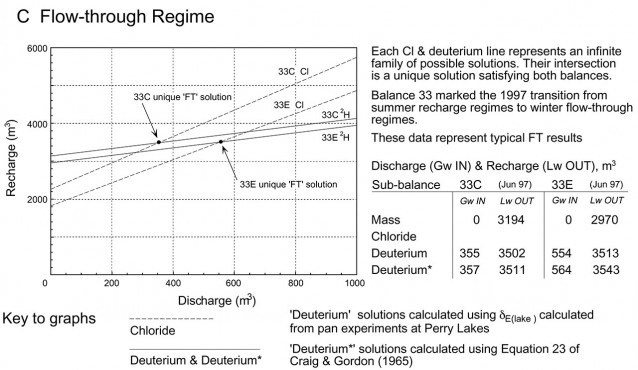
June 1997, winter flow-through regimes re-established. Groundwater is discharged into the lake and lake water is recharged to the aquifer. The mass balance therefore contains two unknowns and cannot be solved. Chloride and deuterium balance solutions plot as intersecting lines. The intersection (representing the solution to two linear equations) describes a unique solution satisfying the conservation of both chloride and deuterium.
The single most significant result of the integrated balances was the non symmetrical nature of East Lake under flow-through conditions. It was assumed that groundwater discharge and recharge would be similar, more or less balancing each other. The data however show that recharge always exceeded discharge. This pattern was established early in the winter and prevailed over both 1996 and 1997. For most of each winter the lakes were always close to or approaching recharge status. The dividing stream line lay close to the up gradient shore in each lake, an observation confirmed experimentally using mini piezometers. It only required a small additional input of storm water to push the lake from flow-through into recharge status. The integrated balance data demonstrate the mechanisms and quantify the extent to which urban wetlands are hydrologically modified by storm water and other non natural inputs.
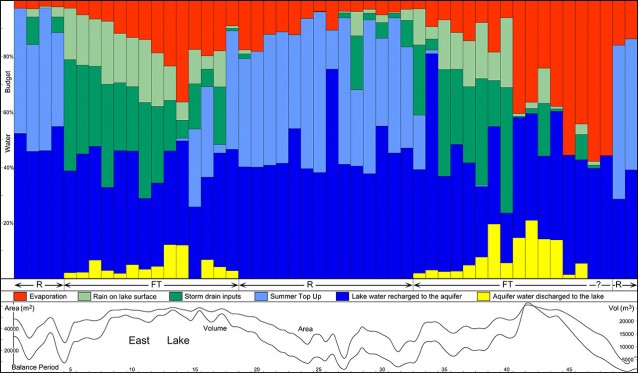
Principal mass components for East Lake plotted over 50 balance periods (April 22, 1996 to January 3, 1998). Average balance period was 12 days. Note that the mass components are plotted as a percentage of the total budget for each balance period NOT absolute quantities (refer next diagram).
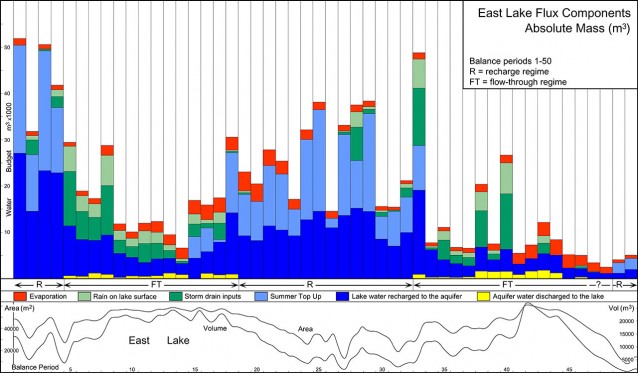
The same data plotted as absolute quantities. The data illustrate clearly how the lake mass budget is dominated by non natural inputs – storm water and summer top up. These push the lake either into or towards recharge flow regimes which eliminate or suppress groundwater discharge into the lake. It is surmised that prior to urbanisation flow-through regimes were maintained all year. During heavy rain events such lakes would move towards or possibly into recharge, but these excursions from flow-through would be transient. The annual trace of lake stage would approximate a smooth sinusoid, similar to seasonal fluctuations in the surrounding unconfined aquifer. Refer thesis for details.
